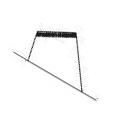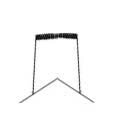Am doing all the planning now for installation of a new free standing wood stove installation this summer. The stove, stove pipe, chimney pipe, hearth, etc. have all been decided. I feel comfortable with all of those items. I want to do this right the first time and not decide two years from now that I have to change part of the installation because I saved a few dollars initially.
My uncertainty revolves around the chimney. The stove will be centered in the great room under the geometric center of a cathedral ceiling. The room was designed with this in mind. That cannot change. My original plan was to run the double wall stove pipe straight up to the chimney support box and from there straight up through the ridge of the roof. My plan was to build a chase around that section of the chimney above the ridge. The chase would be an additional expense but would look good and provide rigidity against the turbulent winds we frequently experience in this area. It was strongly suggested by some respected authorities that I not run the chimney through the ridge of the roof because it is too difficult to properly flash that kind of installation. It was suggested that I insert the chimney 1' - 2' on either side of the ridge. This kind of installation is easier to flash properly.
Here is my dilemma: If I install the chimney to either side of the roof ridge I will need an offset in the chimney pipe or stove pipe. An offset in the chimney pipe above the ceiling will be out of sight but because of the cathedral ceiling, will be a lot more work (and maybe impossible) in an area that has very little working room. This type of installation will also be more expensive because of the labor, framing lumber, elbows or offsets, additional chimney, and chimney supports. Installing the offset in the stove pipe would be unsightly in this particular room and is not really a viable option. The added expenses of installing through the ridge compared to an offset above the ceiling would be similar.
Here are my questions: 1) In terms of the ability of the chimney to draw properly is there any advantage/disadvantage to installing the chimney through the ridge of the roof (straight chimney) compared to 1' - 2' either side of the ridge (double bend chimney)? My intuition is that an installation through the ridge will draw better; 2) If chimney installation either side of the ridge will draw better, which option is better, the windward side or the leeward side?; 3) Does any reader know a contractor around Richfield Springs or Cooperstown, NY who does excellent work on such roofing projects?
Any opinions, suggestions and comments are always welcome.
Have a safe and happy New Year!
John_M
My uncertainty revolves around the chimney. The stove will be centered in the great room under the geometric center of a cathedral ceiling. The room was designed with this in mind. That cannot change. My original plan was to run the double wall stove pipe straight up to the chimney support box and from there straight up through the ridge of the roof. My plan was to build a chase around that section of the chimney above the ridge. The chase would be an additional expense but would look good and provide rigidity against the turbulent winds we frequently experience in this area. It was strongly suggested by some respected authorities that I not run the chimney through the ridge of the roof because it is too difficult to properly flash that kind of installation. It was suggested that I insert the chimney 1' - 2' on either side of the ridge. This kind of installation is easier to flash properly.
Here is my dilemma: If I install the chimney to either side of the roof ridge I will need an offset in the chimney pipe or stove pipe. An offset in the chimney pipe above the ceiling will be out of sight but because of the cathedral ceiling, will be a lot more work (and maybe impossible) in an area that has very little working room. This type of installation will also be more expensive because of the labor, framing lumber, elbows or offsets, additional chimney, and chimney supports. Installing the offset in the stove pipe would be unsightly in this particular room and is not really a viable option. The added expenses of installing through the ridge compared to an offset above the ceiling would be similar.
Here are my questions: 1) In terms of the ability of the chimney to draw properly is there any advantage/disadvantage to installing the chimney through the ridge of the roof (straight chimney) compared to 1' - 2' either side of the ridge (double bend chimney)? My intuition is that an installation through the ridge will draw better; 2) If chimney installation either side of the ridge will draw better, which option is better, the windward side or the leeward side?; 3) Does any reader know a contractor around Richfield Springs or Cooperstown, NY who does excellent work on such roofing projects?
Any opinions, suggestions and comments are always welcome.
Have a safe and happy New Year!
John_M



